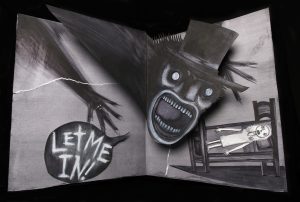Pinedo’s in her essay references the role which reason plays in both classical and postmodern horror. She explains how rationality is defined through classical horror as a distinctly male trait, where irrationality and disorder are distinctly feminine. In many classical horror films, those who exercised logic and reason were members of fields which were dominated by men, which assisted in creating a skewed definition of what reason really is. However, within the demented universe of postmodern horror films, much of the horror comes from the inability to apply reason to a given situation. The limited definition of “reason” created by classical horror is shattered by postmodern horror. Since this essay was written, I feel that postmodern horror has done much to remove the limitations on feminism which the article cites.
The film that comes to mind is The Babadook (2014). The Babadook fulfills all the requirements for postmodern horror presented in the article. There is violent disruption of the normal world caused by a creature from a book gaining consciousness. There are transgressions of boundaries in the way the protagonist abuses her child who has a behavioral disorder, which is a transgression that would not be tolerated of a protagonist in classical horror. There is a violation of rationality in the ways which the creature manifests itself throughout the film. There is no plot resolution, as the protagonist at the end of the film can only defeat the Babadook by keeping it locked in her basement. The film puts an ironic spin on the victim-role which female lead characters often fall into. It is ultimately about the female protagonist dealing with the terrifying thoughts and feelings that accompany mental illness, but it’s post modern bent allows the female protagonist to display her flaws without receiving the seal of moral degeneracy that classical horror would award their female protagonists for similar behavior.
Pictured below is The Babadook’s horrifying monster.

While the most recent films which could fall into the postmodern horror genre could not explicitly be called feminist, films such as The Babadook set up interesting character roles within the genre which prevents the limited social power Pinedo cites. The role of the protagonist herself as a non-sexualized, flawed mother shows the evolution of the female role in postmodern horror since the time this essay was written.
